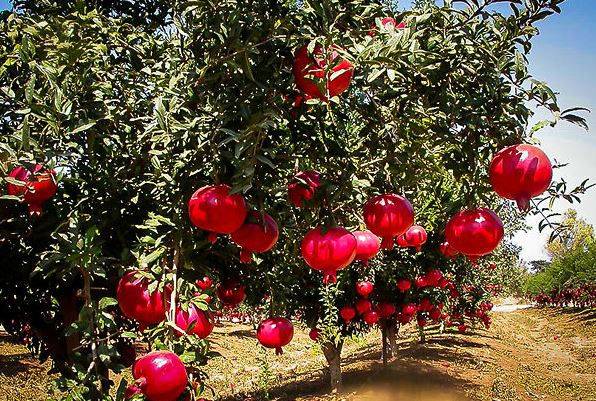
Punica protopunica, commonly known as the pomegranate tree or Socotran pomegranate, is a species of flowering plant in the family Lythraceae. It is endemic to the island of Socotra (Yemen). Its natural habitat is subtropical or tropical dry forests. Cultivated since ancient times in the Mediterranean region of Europe and Africa, pomegranate trees have been prized for thousands of years for their fruit, which contains scores of seeds encased in sweet, tangy pulp.
The pomegranate plant generally grows as a multi-stemmed bush or small tree that can reach a height of 10 to 12 feet at maturity. The branches have thorns or small spines and produce dark green glossy leaves that dry and drop over the winter months.
In spring or early summer, orange to red tubular-shaped flowers appear in clusters along the branches. Pomegranate trees are self-fruitful, with both male and female flower parts on a single tree. Insects and hummingbirds help spread pollen from flower to flower, allowing fruit to form when conditions are right.
Pomegranates thrive in climates with hot, dry summers and cool winters, making them well-suited to Mediterranean climates. However, they are adaptable and can grow in various conditions, including semi-arid environments. These trees are reliably hardy in U.S. Department of Agriculture plant hardiness zones 8 through 11.
Pomegranate trees are relatively slow growers in their early years. When planted from seeds or cuttings, you might expect them to grow about 13-24 inches per year initially. They typically reach maturity in about 3-5 years, at which point they might start producing fruit. The growth rate might slow down as the tree matures but continues at a steady pace if conditions are favorable. In ideal conditions (full sun, well-drained soil, appropriate watering), pomegranate trees can grow more vigorously.
With proper care, they can live for several decades. Some trees are reported to live for 100 years or more, though this is less common and depends heavily on conditions. While they can live long, their most productive years for fruit production might be within the first 30-40 years. After this, fruit production might decrease, though the tree itself can continue to thrive.
The pomegranate fruit is roughly the size of a large orange or grapefruit, with a tough, leathery outer skin that ranges from yellow-orange to deep red when ripe. Inside, it’s filled with numerous seeds, each surrounded by a juicy, translucent aril. These arils are the edible part, varying in color from ruby red to pink. The fruit is a type of berry known botanically as a “pome.” It’s divided into compartments by white, spongy, inedible tissue, with each compartment filled with seeds.
As the tree matures, it will begin to produce fruit that matures on the tree; generally, fruit needs about six or seven months on the tree to be ready for picking. A pomegranate is mature when it makes a tinny, metallic sound when tapped with a finger. A ripe pomegranate should never be pulled off a branch, since this may damage the fruit and possibly the tree’s bark. Rather, use scissors or clippers to cut the small stem that attaches the fruit to the tree.
Pomegranate arils are often eaten fresh, either directly from the fruit or added to salads, yogurt, or desserts for a burst of flavor and color. The fruit juice is popular for its rich, tart flavor and is often consumed on its own or mixed into cocktails, smoothies, or sauces.
Types of Pomegranate Trees
- Wonderful – Originated in Florida, USA, but widely cultivated in California.
- Ambrosia – Developed in California, USA, known for its high juice content.
- Eversweet – A modern variety developed in California, noted for its non-staining juice.
- Ganesh – Originated in India, named after the Hindu god Ganesha, known for early ripening.
- Haku Botan – From Japan, used primarily for ornamental purposes due to its variegated foliage.
- Salavatski – Developed in Russia, valued for its cold hardiness and large fruit.
- Kazake – Also from Russia, another cold-hardy variety with large, sweet fruits.
- Ruby Red – While the exact origin isn’t specified, it’s widely grown in the USA for its bright red fruits.
- Angel Red – Developed in California, known for its resistance to splitting.
- Sweet – The origin isn’t clearly documented, but it’s known for its sweet flavor, suggesting a selective breeding for taste.
- Utah Sweet – Developed in Utah, USA, for its adaptability to cooler climates.
- Purple Heart – Origin not specified, but it’s known for its deep color and sweet flavor.
- Crab – An older variety with origins possibly in the Middle East or Mediterranean, known for its ornamental value.
- Afganski – From Afghanistan, noted for its cold tolerance and large fruits.
- Al-Sirin – Originating from Iran, known for its large fruit size and sweet flavor.